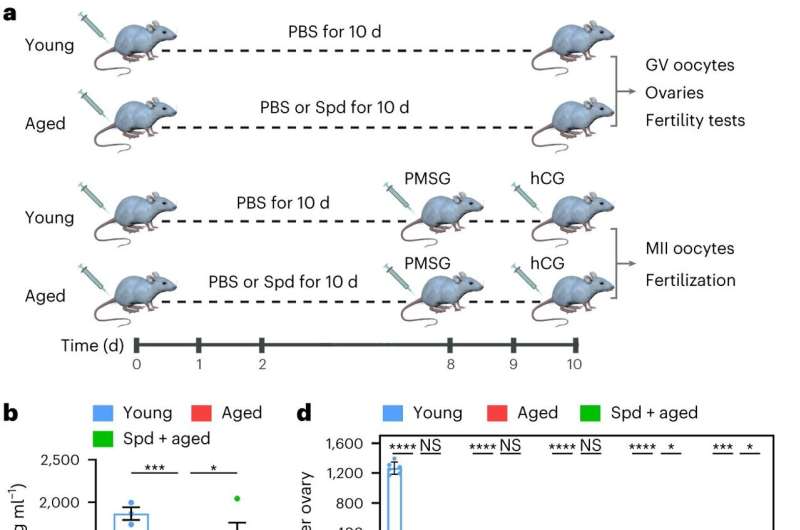October 17, 2023 report
This article has been reviewed according to Science X's editorial process and policies. Editors have highlighted the following attributes while ensuring the content's credibility:
fact-checked
peer-reviewed publication
trusted source
proofread
Spermidine found to rejuvenate oocyte quality by improving mitophagy during female reproductive aging

A team of reproductive biologists at Nanjing Agricultural University has found that spermidine, a polyamine metabolite, helps oocytes clear away damaged mitochondria in mice, thereby improving mitophagy during female reproductive aging.
In their study, reported in the journal Nature Aging, the group sequenced mouse oocyte cell RNA to learn more about how spermidine impacts reproduction in aging mice. Andreas Zimmermann and Frank Madeo, with the University of Graz, have published a News & Views piece in the same journal issue outlining the work done by the team in China.
Prior research and anecdotal evidence have shown that many animals experience declining fertility as they grow older. In this new effort, the research team found a link between spermidine levels in aging mice and fertility issues.
The researchers began by measuring spermidine levels in ovarian tissue samples of mice of different ages—they found that as the mice grew older, their levels of spermidine were reduced. They also noted that the quality of oocytes and follicles fell.
To see if such effects might be reversed, they injected some of the test mice with spermidine, which prevented the degradation of the oocytes and follicles—they also found that giving mice water containing spermidine did the same thing. Taking a longer look, they found that giving test mice spermidine also improved the success rate of blastocysts and resulted in more litters produced in later years than in a control group.
To find out why giving the mice spermidine improved their fertility, the team took a closer look at oocyte cells. They found that as the mice grew older, damaged mitochondria were not cleared away as well as in younger mice. They sequenced the cells' RNA and found different expression patterns from genes between young and older mice. They also found that mice given spermidine did not lose their ability to clear away damaged mitochondria, and in fact, saw enhanced mitochondrial function. The researchers found similar effects when they gave pigs spermidine.
The research team suggests the possibility of using spermidine as a therapy for promoting fertility in women who experience problems getting pregnant as they get older.
More information: Yu Zhang et al, Polyamine metabolite spermidine rejuvenates oocyte quality by enhancing mitophagy during female reproductive aging, Nature Aging (2023). DOI: 10.1038/s43587-023-00498-8
Andreas Zimmermann et al, Spermidine promotes fertility in aged female mice, Nature Aging (2023). DOI: 10.1038/s43587-023-00495-x
© 2023 Science X Network



















